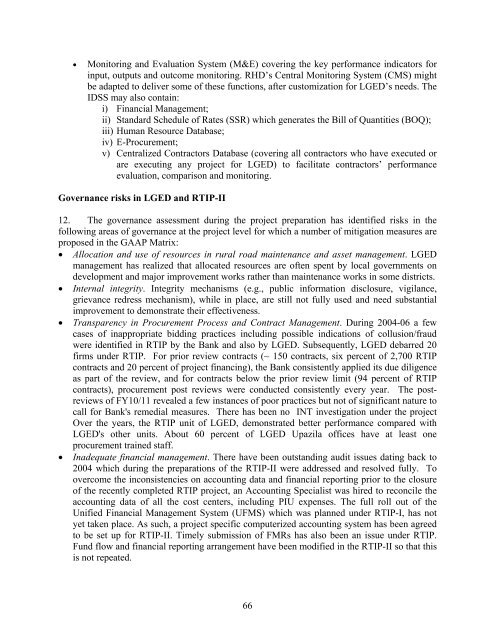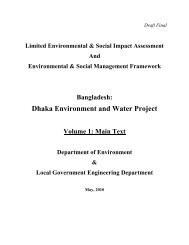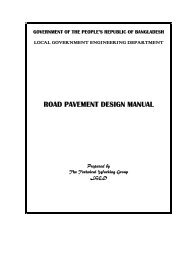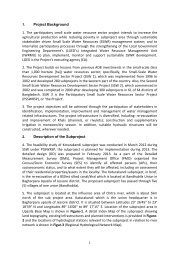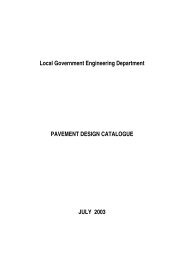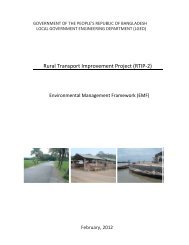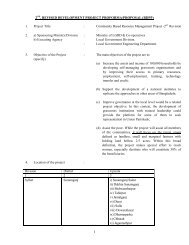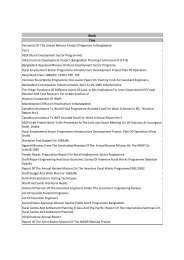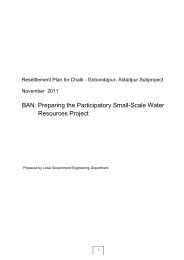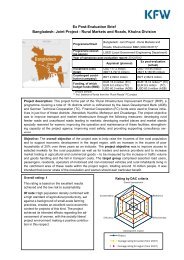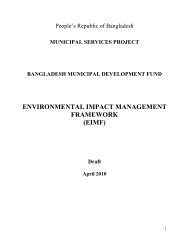PAD - LGED
PAD - LGED
PAD - LGED
You also want an ePaper? Increase the reach of your titles
YUMPU automatically turns print PDFs into web optimized ePapers that Google loves.
• Monitoring and Evaluation System (M&E) covering the key performance indicators for<br />
input, outputs and outcome monitoring. RHD’s Central Monitoring System (CMS) might<br />
be adapted to deliver some of these functions, after customization for <strong>LGED</strong>’s needs. The<br />
IDSS may also contain:<br />
i) Financial Management;<br />
ii) Standard Schedule of Rates (SSR) which generates the Bill of Quantities (BOQ);<br />
iii) Human Resource Database;<br />
iv) E-Procurement;<br />
v) Centralized Contractors Database (covering all contractors who have executed or<br />
are executing any project for <strong>LGED</strong>) to facilitate contractors’ performance<br />
evaluation, comparison and monitoring.<br />
Governance risks in <strong>LGED</strong> and RTIP-II<br />
12. The governance assessment during the project preparation has identified risks in the<br />
following areas of governance at the project level for which a number of mitigation measures are<br />
proposed in the GAAP Matrix:<br />
• Allocation and use of resources in rural road maintenance and asset management. <strong>LGED</strong><br />
management has realized that allocated resources are often spent by local governments on<br />
development and major improvement works rather than maintenance works in some districts.<br />
• Internal integrity. Integrity mechanisms (e.g., public information disclosure, vigilance,<br />
grievance redress mechanism), while in place, are still not fully used and need substantial<br />
improvement to demonstrate their effectiveness.<br />
• Transparency in Procurement Process and Contract Management. During 2004-06 a few<br />
cases of inappropriate bidding practices including possible indications of collusion/fraud<br />
were identified in RTIP by the Bank and also by <strong>LGED</strong>. Subsequently, <strong>LGED</strong> debarred 20<br />
firms under RTIP. For prior review contracts (~ 150 contracts, six percent of 2,700 RTIP<br />
contracts and 20 percent of project financing), the Bank consistently applied its due diligence<br />
as part of the review, and for contracts below the prior review limit (94 percent of RTIP<br />
contracts), procurement post reviews were conducted consistently every year. The postreviews<br />
of FY10/11 revealed a few instances of poor practices but not of significant nature to<br />
call for Bank's remedial measures. There has been no INT investigation under the project<br />
Over the years, the RTIP unit of <strong>LGED</strong>, demonstrated better performance compared with<br />
<strong>LGED</strong>'s other units. About 60 percent of <strong>LGED</strong> Upazila offices have at least one<br />
procurement trained staff.<br />
• Inadequate financial management. There have been outstanding audit issues dating back to<br />
2004 which during the preparations of the RTIP-II were addressed and resolved fully. To<br />
overcome the inconsistencies on accounting data and financial reporting prior to the closure<br />
of the recently completed RTIP project, an Accounting Specialist was hired to reconcile the<br />
accounting data of all the cost centers, including PIU expenses. The full roll out of the<br />
Unified Financial Management System (UFMS) which was planned under RTIP-I, has not<br />
yet taken place. As such, a project specific computerized accounting system has been agreed<br />
to be set up for RTIP-II. Timely submission of FMRs has also been an issue under RTIP.<br />
Fund flow and financial reporting arrangement have been modified in the RTIP-II so that this<br />
is not repeated.<br />
66


